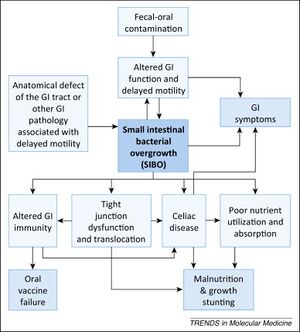Small Intestinal Bacterial Overgrowth
Overview
Small intestinal bacterial overgrowth (SIBO) is defined as the abnormal increase in the overall bacterial population in the small intestine. [1] Common symptoms of SIBO include diarrhea, flatulence, abdominal pain and bloating. [2] [3]Currently there is no single valid test for SIBO, but common ways of screening for SIBO include small-bowel aspiration and quantitative culture and breath testing. [4]
SIBO was first suggested by Barker and Hummel in their 1939 publication “Macrocytic anemia in association with intestinal strictures and anastomoses.”, providing key findings for both the study of Macrocytic anemia and the study of SIBO. [5]

At right is a sample image insertion. It works for any image uploaded anywhere to MicrobeWiki. The insertion code consists of:
Double brackets: [[
Filename: PHIL_1181_lores.jpg
Thumbnail status: |thumb|
Pixel size: |300px|
Placement on page: |right|
Legend/credit: Electron micrograph of the Ebola Zaire virus. This was the first photo ever taken of the virus, on 10/13/1976. By Dr. F.A. Murphy, now at U.C. Davis, then at the CDC.
Closed double brackets: ]]
Other examples:
Bold
Italic
Subscript: H2O
Superscript: Fe3+
Testing for SIBO
Interactions Between SIBO and Other Systemic Conditions
Include some current research, with a second image.
Conclusion
Overall text length (all text sections) should be at least 1,000 words (before counting references), with at least 2 images.
Include at least 5 references under References section.
References
- ↑ “Small Intestinal Bacterial Overgrowth (SIBO).” Mayo Clinic, Mayo Foundation for Medical Education and Research, 6 Jan. 2022, https://www.mayoclinic.org/diseases-conditions/small-intestinal-bacterial-overgrowth/symptoms-causes/syc-20370168.
- ↑ Sachdev, Amit H, and Mark Pimentel. “Gastrointestinal bacterial overgrowth: pathogenesis and clinical significance.” Therapeutic advances in chronic disease vol. 4,5 (2013): 223-31. doi:10.1177/2040622313496126
- ↑ Bohm, Matthew, et al. “Diagnosis and Management of Small Intestinal Bacterial Overgrowth.” Nutrition in Clinical Practice, vol. 28, no. 3, 2013, pp. 289–299., https://doi.org/10.1177/0884533613485882.
- ↑ Saad, Richard J., and William D. Chey. “Breath Testing for Small Intestinal Bacterial Overgrowth: Maximizing Test Accuracy.” Clinical Gastroenterology and Hepatology, vol. 12, no. 12, 2014, pp. 1964–1972., https://doi.org/10.1016/j.cgh.2013.09.055.
- ↑ Barker, W. H., and L. E. Hummel. "Macrocytic anemia in association with intestinal strictures and anastomoses." Bull Johns Hopkins Hosp 64.2 (1939): 15.
Edited by Yufan Lu, student of Joan Slonczewski for BIOL 116 Information in Living Systems, 2022, Kenyon College.
